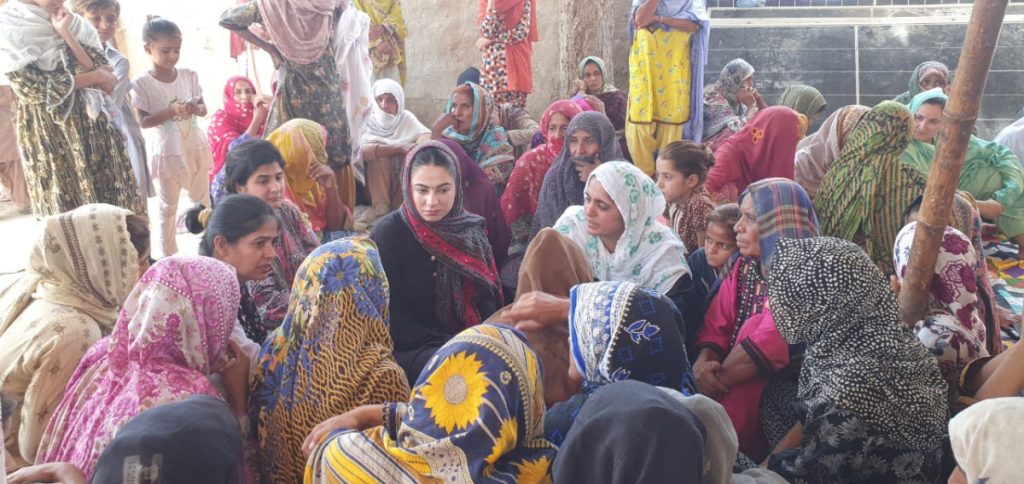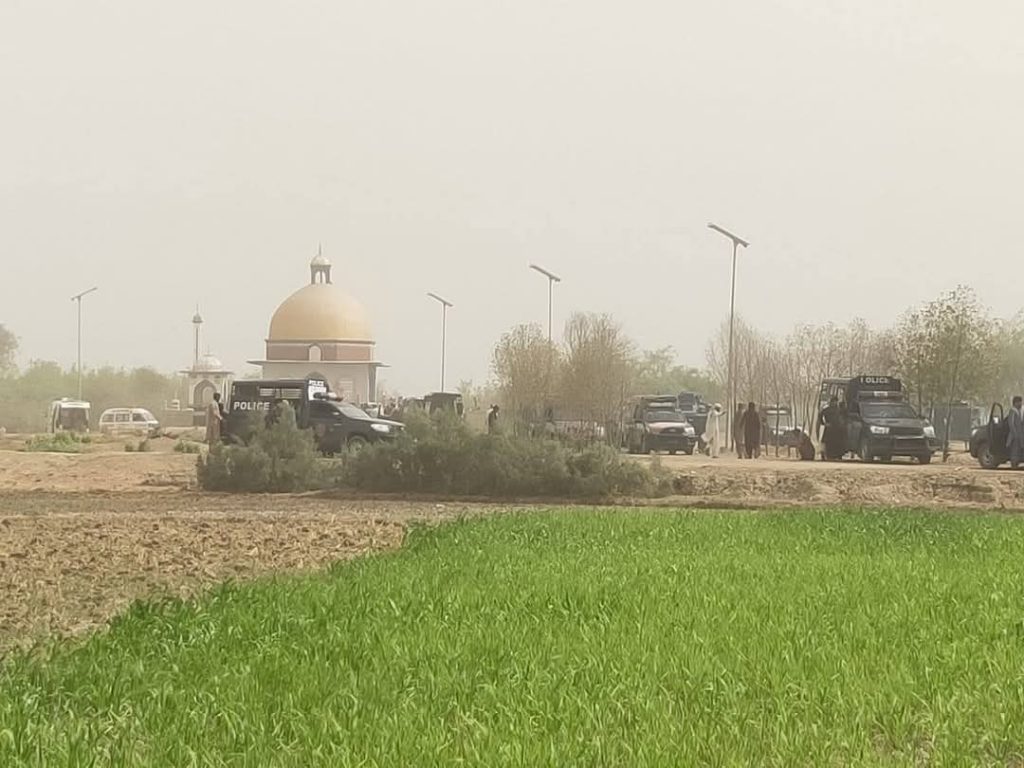In Sindh, Unending Police Brutality for Villagers Protesting Against Canals on the Indus
Moro (Pakistan): Dozens of village women sat cross-legged on the dusty, mud-packed floor, surrounding a young woman in silence. One of them broke the quiet, recalling the words of Zahid Laghari: “If I am killed, you must stand before my body and say loudly – 'This is my martyr husband who sacrificed his life for Sindh and the Sindhu river'.”
But Anita Laghari – just 22 years old – could not bring herself to speak those words. “She is in shock and deep grief,” one villager said gently.
Anita is the widow of Zahid Laghari, 25, who was gunned down on May 20. She is seven months pregnant.

Villagers offer condolences to Anita Laghari, the widow of a man killed in the Sindh-canal protests. Photo: By arrangement
Their village, Laghari Bajrani, lies far from the city of Moro in Sindh Province. The road to reach it is uneven and blanketed in dust, taking nearly 30 minutes by vehicle. It leads to the home of the grieving family, where villagers had just buried Zahid – a young man they now speak of with reverence and sorrow.
The scorching sun bore down, and hot winds stirred the silence. Still, no one seemed to care about the oppressive heat. They sat together, mourning and consoling one another.
“He gave his life for the Sindhu daryah,” one said. 'Daryah' means 'river.'
On May 20, nearly twenty young men on motorcycles and bicycles gathered at the Moro Bypass to protest the construction of six canals and the spread of corporate farming in Sindh. The demonstration was peaceful. Yet police opened fire, directly and indiscriminately, on the small group of protesters. Zahid Laghari was killed on the spot; several others were critically injured.
As the protesters tried to gather Zahid’s body and help their wounded companions, a few rushed to the residence of Sindh’s home minister, Zia-ul-Hassan Lanjar, to protest the killing of their friend.
In response, police registered four first information reports (FIRs) against the protesters, charging them with terrorism and accusing them of setting fire to the minister’s residence. The protesters have strongly denied all allegations. Meanwhile, police have refused to file an FIR on behalf of the victims.
On May 23, one of the protesters, Irfan Laghari, believed to be in his early thirties, succumbed to his injuries. Two days later, on May 25, police buried his body without the family’s consent and declared him laawaris, or unclaimed. The family rejected the police’s conditions for handing over the body. As a result, they were never allowed to bury their son.

Police buried Irfan under a heavy security. Photo: By arrangement
“We are not terrorists, we are lovers of the Sindhu river,” said Mumtaz Laghari, 25, who led the May 20 protest. “The Sindh government has already killed our fellow villagers. If they want to continue killing us, we won’t step back. All we want is to protect the Sindhu. If they file piles of FIRs or throw baseless accusations, we will face every injustice.”
Police had guns, protesters had flags
Allah Bachayo Laghari, 72, a retired schoolteacher and author of the book Dadlo Daryah ('Beloved River'), said the young men and boys from his village had been protesting the construction of six canals and the expansion of corporate farming in Sindh for a while now. Speaking to The Wire, he noted that May 20 marked the fourth time they had gathered to register their protest.

Allah Bachayo Laghari. Photo: By arrangement.
His village, Laghari Bajrani, has a population of more than 12,000. The residents, along with those in neighbouring villages, are politically aware and deeply committed to Sindh and the Sindhu.
“If locals do not protest against these anti-Sindh projects,” he said, “Sindhis will be destroyed.”
He said that he and others had received threats in the days leading up to the demonstration. Still, the younger villagers were determined to go forward. They had promised the protest would remain peaceful and last only a few hours, as it had in the past.
“What troubles us most,” he continued, “is that the state allowed lawyers to hold a protest at Baberlo Bypass in April over the same issue. But when we raise our voices, we are shot.” “It shows they – the lawyers – were aligned with the government, and we are left powerless,” he said.
The violence, villagers say, did not erupt spontaneously. According to eyewitnesses, the police assault on the protest was deliberate and premeditated. Protesters allege that men in security force uniforms opened fire without warning.
Waseem Laghari, 25, who was among the demonstrators, said they had no idea why the police suddenly began shooting. “They didn’t even try to speak to us or issue a warning,” he said. “They opened fire first and only afterward did they record a video, pretending to announce a warning.”
“We were carrying nothing but flags,” Waseem added quietly. “If we had weapons, maybe we could have defended ourselves. But we were unarmed and that’s why they had no hesitation in shooting at us.”
Allah Bachayo Laghari recalled how his village had previously supported peaceful protests. During the lawyers’ demonstration in Baberlo earlier this year, some young men from his village had helped initiate a sit-in at the Moro Bypass. “We gave people food and shelter to those stranded when traffic was blocked,” he said. “For 12 days, not a single car was damaged. How could anyone believe we would suddenly turn violent on May 20?”
He suspects that the village’s consistent involvement in protests against the construction of canals and corporate land acquisition had drawn the ire of security agencies. “On May 20, many of those killed were the same young men who had supported the lawyers’ protest,” he said. “They were targeted.”
According to Waseem, the violence continued even after the death of Zahid Laghari. As villagers gathered to protest with Zahid’s body, police vehicles attempted to drive into the crowd, he said. “We lay down in front of the vehicles to stop them from breaking the sit-in,” he said. “That’s when we knew that they were prepared to run us over.”
He also alleged that some of the personnel present were not regular police officers. “We noticed men who looked like they belonged to other security agencies,” he said. “They weren’t in standard police uniforms.”
'Who set fire to the home minister's house?'
Ameer Laghari, a local resident, said panic spread through the village when relatives began calling with news that several protesters had been injured. Dozens of villagers rushed to the hospital and to the site of the demonstration to register their outrage over the police’s use of force.
He said only a small group of people gathered outside the house of Sindh home minister Zia-ul-Hassan Lanjar to protest. “That house is a public office, not a private residence,” Ameer said. “Very few people reached the main gate. Most were still at the hospital.”
According to Ameer, the protesters were unarmed and carrying only sticks. “They didn’t even enter the house,” he said. “The fire started from inside.”
He referred to a video that circulated shortly after the incident, showing a local elected councillor admitting that he had opened fire on protesters. “He said it himself,” Ameer noted. “He shot at people who had nothing but sticks. Several were wounded because of his firing.”
Waseem Laghari, another protester, raised questions about those responsible for the violence. “Who were those people who suddenly appeared and set fire to vehicles and the house?” he asked. He called for an independent investigation, arguing that the FIR filed by police included names of individuals who had not even been near the scene. “Many of them were at the hospital helping the injured,” he said.
“This was an attempt by Lanjar and his people to deflect attention from the police’s brutality,” Waseem added. “Even the councilor who opened fire has not been named in the FIR.”
Repeated attempts to reach Sindh home minister Zia-ul-Hassan Lanjar for comment were unsuccessful. He did not respond to phone calls or text messages.
Also read: 'Laawaris': Sindhi Student Fights for Life in ICU After Joining Protest
An FIR against victims
Advocate Noor Tunio, who is representing the protesters, said police officers refused to register an FIR on behalf of the victims, allegedly telling him they were under orders from higher authorities not to cooperate. “Some officers told me they wanted to leave Moro district because of the pressure they were under,” Tunio said.
Several of the injured remain in critical condition at the hospital, but Tunio said the administration has not been cooperating with the families. “Even those who came forward to donate blood were abducted,” he alleged. According to him, nearly 30 people, either donors or those accompanying victims in ambulances, have gone missing.
No link to banned organisations
Allah Bachayo rejected government claims linking their protest to the banned organisation Jeay Sindh Muttahida Mahaz (JSMM). He said the villagers have long-standing ties with several Sindhi nationalist parties, including some that participate in parliamentary politics, but insisted they have no affiliation with JSMM. “This is government propaganda aimed at discrediting our struggle against the six canals and corporate farming,” he said.
Waseem Laghari also criticised JSMM leader Shafi Muhammad Burfat, accusing him of falsely associating peaceful nationalist activists with his group. According to Waseem, Irfan Laghari had once posted on Facebook that he was not a member of JSMM, but Burfat later circulated a protest photo from Irfan’s account, falsely implying a connection. “That act was not only misleading – it was illegal,” Waseem said.
He and others in the village stressed that the May 20 protest was organised voluntarily by residents of Laghari Bajrani, with no involvement from JSMM. “Our demonstration was solely for the protection of the Indus river,” he added.
For justice
Marui Laghari, a young woman from the village, arrived to offer condolences to Anita, Zahid’s relative. Speaking through tears, she said even the bodies of their loved ones seemed to be asking for justice. “What was their crime?” she asked. “Just for protesting against six canals? Are we not allowed to raise our voice when they cut off our water and kill the Indus?”
Inside Zahid’s family home, grief echoed through the rooms. His eight sisters wept as they mourned the loss of their youngest brother. One sister, who had been in another city, recalled receiving a phone call that someone had been shot. “When I reached my parents’ home, I found out the ‘someone’ was my brother Zahid,” she said, sobbing.
Despite the anguish, the women of the village remained resolute. They vowed to join the protests alongside the men, standing against the canal projects and corporate farming that they believe threaten their land and river.
“The government has crossed every limit,” said one of the women. “There’s nothing left to keep us in our homes.”
“Why should I be afraid,” added Marui, “when we are fighting for the Sindhu?”
Manzoor Laghari, Zahid’s 45-year-old brother, said, “If the government kills him and his brother, then their three little sons will carry on the struggle against the six canals. Our people in the village will never give up the fight for the Sindhu River.”
This article went live on May twenty-sixth, two thousand twenty five, at thirty-five minutes past four in the afternoon.The Wire is now on WhatsApp. Follow our channel for sharp analysis and opinions on the latest developments.




